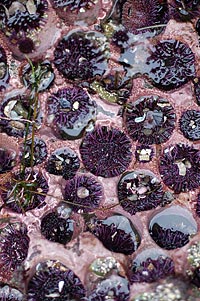Dental delight! Tooth of sea urchin shows formation of biominerals
Some of the most common minerals in biology, including those in bones and shells, have a mysterious structure: Their crystals are positioned in the same orientation, making them behave as one giant crystal, even though they do not look like a faceted crystal.

Pupa Gilbert, a professor of physics, has found a new mechanism that may explain how crystals form in many types of biominerals, including shellfish, eggshells and the enamel in human teeth. Gilbert made her discovery by studying the purple sea urchin Strongylocentrotus purpuratus, shown here in a tide pool at Point Arena, Calif., on Dec. 1, 2009.
It’s as if grains of salt were spilled on a rug, yet instead of landing randomly, all wound up with exactly the same angle and rotation.
In a new study in the Journal of the American Chemical Society, Pupa Gilbert, a professor of physics at the University of Wisconsin–Madison, has explained this seemingly miraculous feat of nature.
Gilbert and colleagues, including postdoctoral researcher Christopher Killian and biomineral expert Joanna Aizenberg of Harvard University, studied the tooth of the purple sea urchin. Gilbert adds that the same process may occur in mollusk shells and in the bones and teeth of vertebrate animals.
“Many of these biominerals are highly co-oriented,” Gilbert says. “If you look at the nanometer scale, the crystals share a single orientation. But they are separate from each other, which raises an interesting question: How do they orient, how do they come to behave as if they were single crystals?”
The sea urchin is a common marine animal that eats algae and small animals and lives in tide pools or shallow water. Urchins use their five long teeth to grind away rock to make a shallow pocket where they can live protected behind a wreath of sharp, bony spines.
Gilbert’s fascination with the urchin’s tooth follows a long tradition: Aristotle, the Greek naturalist and philosopher, wrote about the urchin in about 343 BC. Indeed, the teeth are held in a “jaw” called “Aristotle’s lantern.”
The crystal in an urchin’s tooth originates as a powdery, wet, “amorphous” form of the common mineral calcium carbonate, the major constituent of limestone.
As Gilbert studied the teeth using a high-resolution X-ray microscope, she identified how crystallinity propagates through the forming sea urchin tooth.
To understand how a shapeless material is converted into a hard, complex structure made from a single crystal, Gilbert suggests imagining “a structure built of mud, in this case, wet amorphous calcium carbonate. You can shape it any way you want, then remove the water, and finally let crystallinity propagate through the amorphous material, one nanoparticle at a time. While building biominerals, the animal harnesses chemistry and physics to produce the forms we see.”
The transformation results in a single large crystal with “the exact same organization and orientation in different locations,” says Gilbert. “One material grows into another, the crystal into the amorphous; it’s a solid-state transformation, with no transport, no gaining or losing of water.”
Calcite, the resulting crystal, is tough enough to grind away limestone or sandstone under the sea urchin.
Gilbert suggests the same process may account for a variety of biological minerals. Co-oriented crystals occur in shells, teeth, coral, eggshells, pearls and the magnetic grains that homing pigeons use to sense Earth’s magnetic field, she says.
Animal bones provide an important example of co-oriented crystals, she adds. “Why does a bone look so complicated at the microscopic scale? Because it starts from an amorphous precursor mineral and then is crystallized. This was brilliantly shown by Julia Mahamid in 2008.” Lia Addadi and Steve Weiner of Israel’s Weizmann Institute of Science pioneered the study of biominerals, she adds.
A better understanding of how bone forms could be helpful in the struggle to control the bone-thinning disease osteoporosis.
Large, expensive single crystals are used in many solar panels that make electricity, Gilbert says. “Maybe they could start from an amorphous precursor and propagate crystallinity through that. Maybe one day we will have solar panels inspired by the lowly sea urchin.”
Evolution has crafted a clever means of forming hard, complicated crystals, yet the control mechanism remains to be explored. “Organisms are really good at keeping things amorphous as long as necessary to change them into their final shape,” says Gilbert. “Crystallization before the material is ready would be detrimental.”
Gilbert, who has spent years exploring how organisms make mineral structures, still expresses wonderment at the biological solution she has observed. “The plates in a sea urchin tooth grow far away from each other, so how do all these plates form crystals that are exactly in the same register, to fractions of a degree? Now we know how: they have bridges connecting all the plates. The bridges look exactly like Roman bridges, with long decks, and arched piers.”
Early in the life of a sea urchin, she says, one tiny crystal forms, “and the same crystal keeps growing through bridge-connected plates in the continuously forming tooth throughout the 60-year lifetime of the urchin.”




